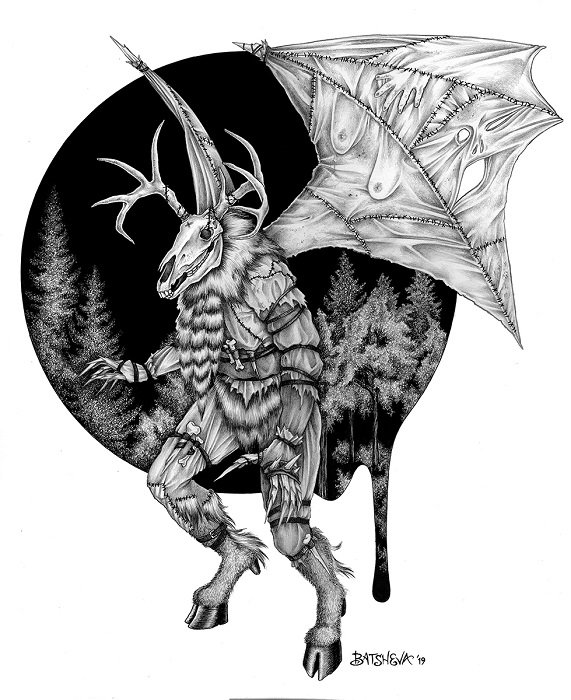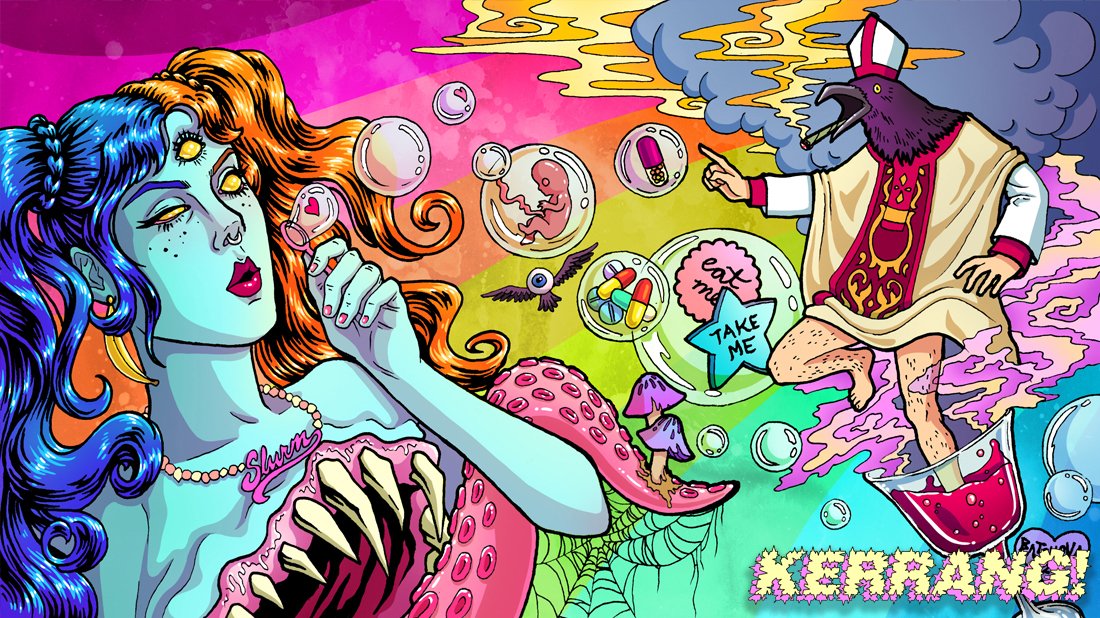Illustrations, Black Coffee & Horror Movies: An Interview With Daniella Batsheva
Kerrang! is one of the biggest alternative music magazines in the world and earlier this year visual artist Daniella Batsheva has been named its first-ever female lead illustrator.
Daniella is known for fusing digital line work, with traditional hand drawing. She combines detail-heavy and bold-coloured images with issues such as mental health, sex, drugs and female empowerment.
In this conversation, she reflects on self-portraits by Vigee Le Brun, her style, and what she is working on at the moment.
Daniella Batsheva. Image courtesy of the artists.SAH: Kerrang! has appointed you as its first female lead illustrator. Tell us about yourself and your journey so far.
DB: This is always a tough question to answer because I try to think about how to tell people about myself and I go completely blank.
Thereās so much thatās happened since 2020 alone, and itās been a whirlwind of getting thrown around. For the sake of keeping it simple, I am an illustrator and I work for a lot of different companies, Kerrang! being the newest, and Iāve worked everywhere from Los Angeles to Tel Aviv.
I like a black coffee in the morning and I can make an excellent curry from scratch!
Artwork by Daniella Batsheva.SAH: Can you give our readers some background on your art? How has your style changed over time?
DB: Iām definitely a product of my environment and my work is influenced by everything from Medieval Illuminations to Art Nouveau to Sandylion stickers. From the very start, it was heavily suggested that I market myself as someone who could potentially do packaging for Bratz Dolls, but after a couple years of forcing that, I was really unhappy with it. I ended up overhauling everything I did.
I stopped pandering to certain crowds and drew whatever made me happy.
My work has always fallen under the umbrella of āalternativeā or āhorrorā but I started really considering what that meant to me a few years ago. Iāve had issues with consolidating my personal interests with my cultural background as a Yemeni-Jewish person, and now Iām exploring the idea of bringing that into my work.
SAH: Can you use 3 words to describe your work?
DB: Bold, warm, haunted.
SAH: Your work is incredible. How do you go about transforming an idea into a finished illustration?
DB: Thank you so much! I wish I had something more interesting to say, but my methods are very formulaic.
Itās always been āsketch, final drawing, refine, finishā sometimes with little bumps of changes along the way. The first thing I tell a client is that I want them to have fun with it and I ask them to send me tons of references and ideas, even if they donāt align.
Iāll always find a common thread in the reference photos and be able to pinpoint exactly what they're looking for.
As far as method goes, I physically draw each illustration with pencil and ink, so thereās an original black and white version of each piece. I then scan it in and color it on Photoshop. Iām pretty content with Photoshop because Iām a fan of cell shading and flat colors, so that keeps things simple for me.
GArtwork by Daniella Batsheva.Artwork by Daniella Batsheva.SAH: Who are your biggest influences? Is there a particular artist that inspired your practice?
DB: Thereās no single influence, and sometimes influences will change depending on my mood or the subject matter Iām working with. There are probably around 500 artists that I could say inspired me, but itās not quite so high-brow.
It really started with horror movies and childrenās books because I became obsessed with being an illustrator once I became self-aware as a toddler.
Over the years, Iāve been influenced by Vigee Le Brun, John Tenniel, Louis Theophile Hingre, Clive Barker, Dave Glass Riddick, Camille Rose Garciaā¦ I mean, the list goes on and on.
SAH: If you could purchase any single work of art ever made, what would it be?
DB: Vigee Le Brunās āSelf-portrait in a Straw Hatā or Nadir Quintoās fairy wedding piece from Thumbelisa.
Iāve always been drawn to Vigee Le Brunās self-portrait and was completely mesmerized when I stumbled into it at the National Gallery in London. As for Nadir Quinto, I had Thumbelisa while living in Israel as a child, and the illustrations from that book were mind-blowing to me. Still are. I love the color palettes and linework.
I love how pleasant it is, even a bit naive, while still being bold. We donāt see too much work like that anymore. I donāt know the title of the actual piece, I think it was just one part of the whole commission, but itās my favourite piece from that entire book.
If Iām not mistaken, I remember reading that it was banned in the US, for whatever reason, and is extremely rare now.
Artwork by Daniella Batsheva.SAH: What are you watching, listening to or following that you would recommend?
DB: Well, Iām really bad with TV. As one of my friends said, āTV shows are not your medium.ā
I donāt have the patience to sit down and watch many things now, sometimes a horror movie because theyāre fun, but I mostly get bored of it. Actually, I have watched one TV show recently and itās called āParanormal Caught on Camera.ā
I watch it because my friend Susan Slaughter is one of the commentators!
Sheās very informative and I love hearing what she has to say. Embarrassingly, I kind of treat the show the way other people treat sports. Iāll yell at the TV and scream about how the dress on the apparition is not Georgian or Victorian, but an Edwardian cut, so it has to be fake. Whenever I see Bigfoot, I yell, āMy people!ā
Other than that, Iāve recently reread Kitchen Confidential by Anthony Bourdain and have binge-listened to The Magnus Archives podcast.
Artwork by Daniella Batsheva.SAH: Whatās next for you? What are your goals?
DB: Right now, Iām working on multiple pitch decks, which will never see the light of day unless theyāre greenlit.
Kerrang! is a priority so, whenever they have an article that could use an illustration, Iāll be there for them. Iām also working with arts and entertainment collective called Trashville, providing posters for them at multiple music venues across London.
Itās less of a āgoalā and more of a bucket list for me. Hopefully, in the future, I would love to do illustrations for an environmental group, something like the London-based Thames21. I would love to do something fashion related, beyond just t-shirt graphics.
In the immediate future, I'm aiming to create a series of pieces where I explore integrating my cultural background with my interests, because Iāve never seen a Jewish āMiddle Eastern Gothicā before. Iāve been in talks with a space in London that could potentially be where I have this future exhibition.
SAH: What advice would you give somebody who has just started their artistic career?
DB: I have to be brutally honest and say that I canāt, in good faith, recommend this.
Itās insane to attempt in this day and age because things are so messed up worldwide. People have the attention span of a gnat because of screens and algorithms, and I almost feel like there is less and less place for the arts. But, if youāre like me, and youāve already made the commitment - donāt have a plan B. If you have a plan B, youāre going to fall back on it.
You have to be willing to give up everything to invest in yourself and your future as an artist. For someone with a comfy home and squishy, warm family, you might want to avoid the arts altogether. Go be a realtor. Spare yourself because itās brutal out here. You have to be crazy to make it work. I wish I had something more positive to say, but going for this career path is a labor of love.
If that didnāt scare you, godspeed! Iāll see you out on the battlefield. Haha!
More information:
š m
š
š






